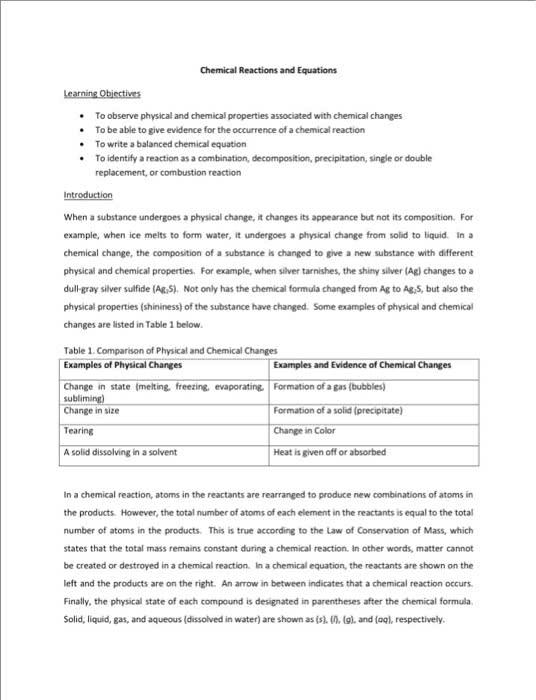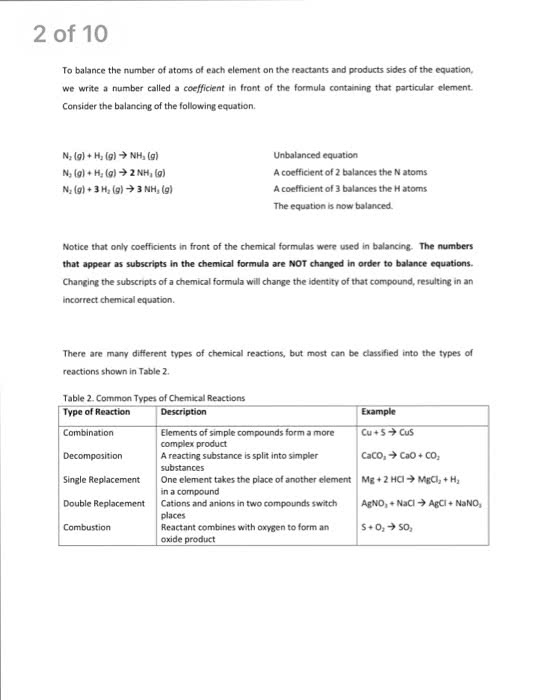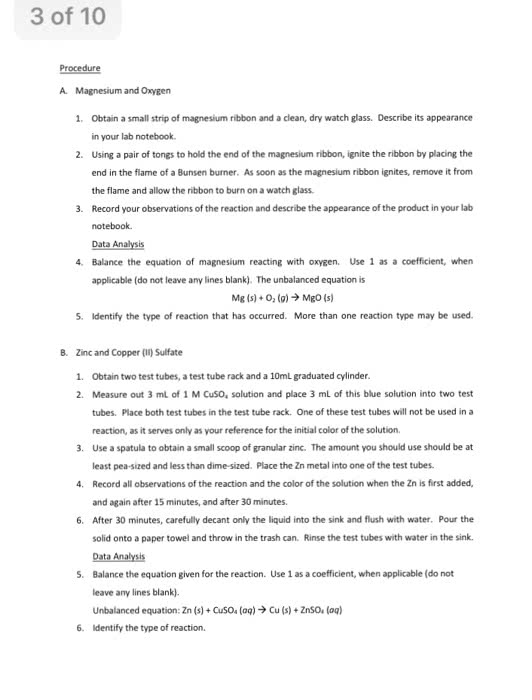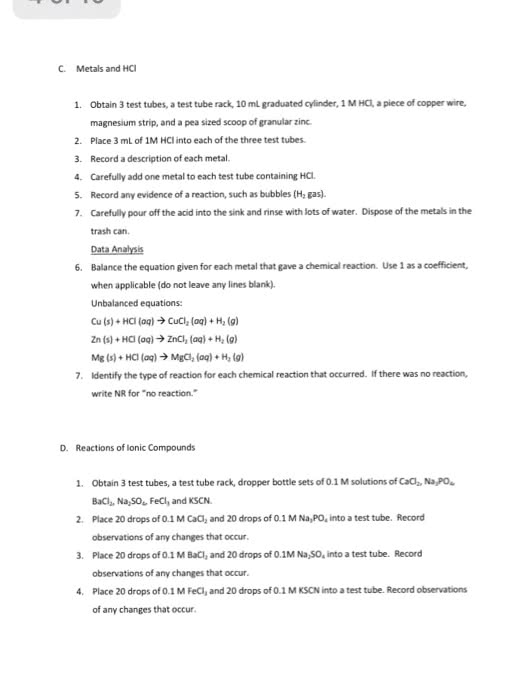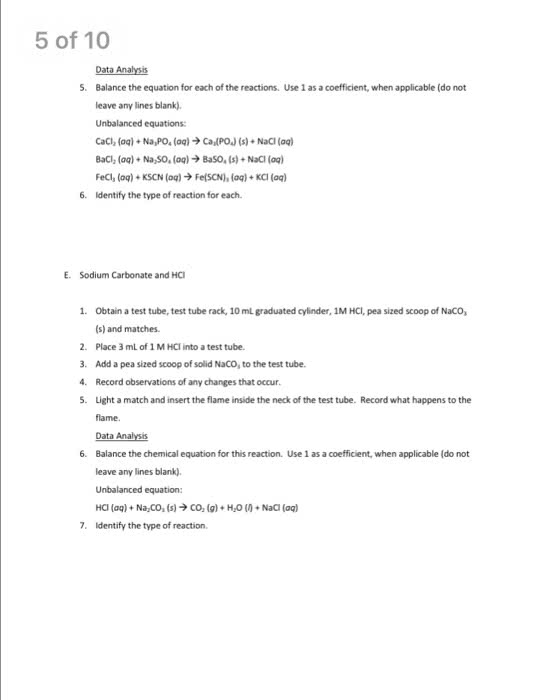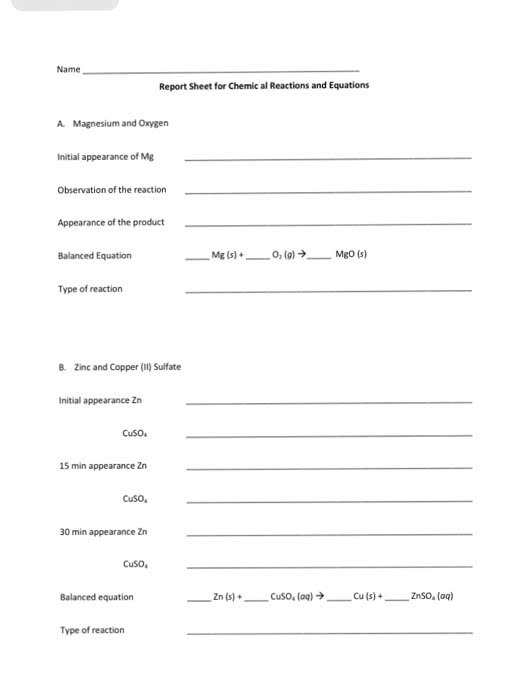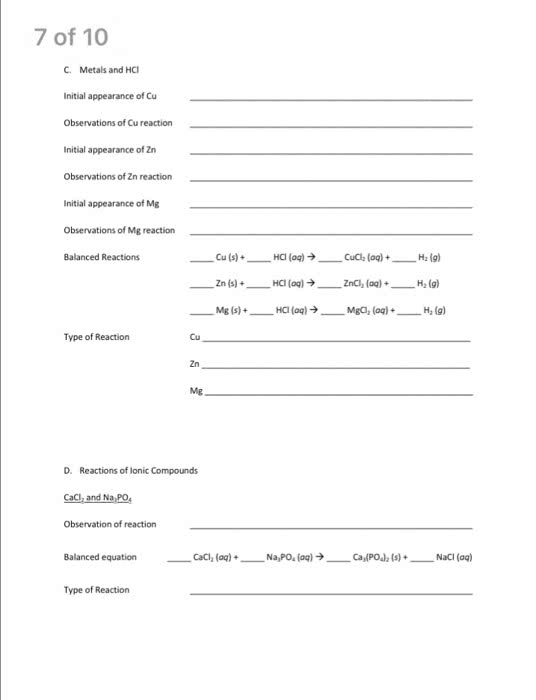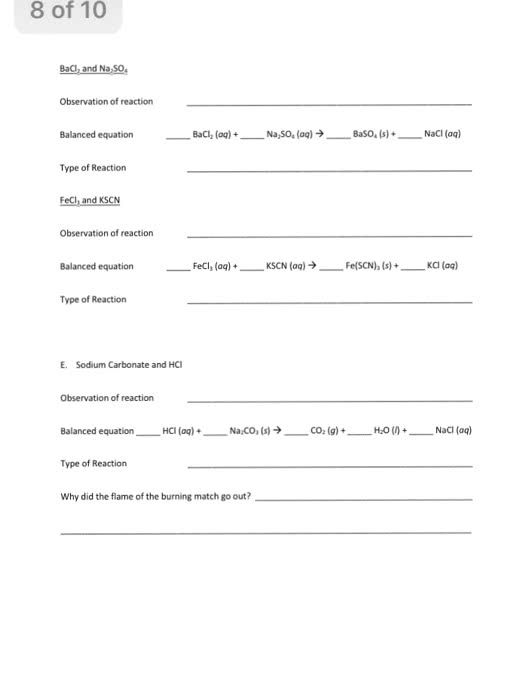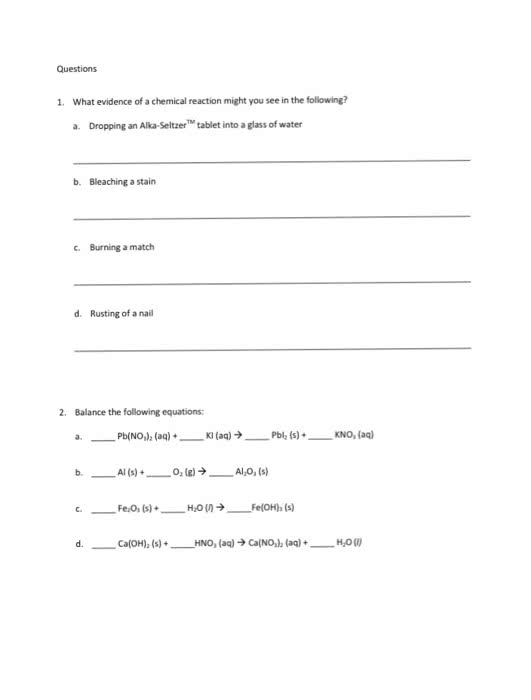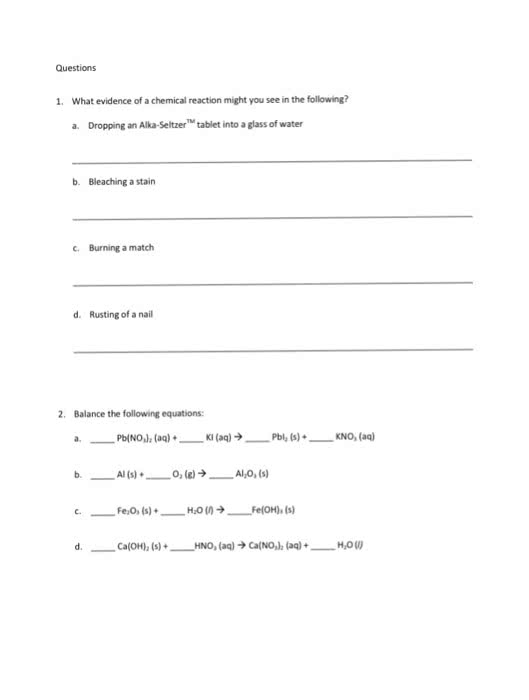The equation Mg + HCl ï®MgCl2 + H2 can be balanced by _____.
A) Changing the coefficient of Mg to 2
B) Changing the coefficient of HCl to 2
C) Changing the coefficient of MgCl2 to 12 .
D) Changing MgCl2 to MgCl
E) Changing H2 to H
In the reaction below, how many molecules of water can be made from 38 molecules of C6H12O6?
C6H12O6 + 6O2 ï® 6H2O + 6CO2 A) 38
B) 6
C) 144
D) 228 E) 44
In the chemical reaction H2SO4 + 2NaOH ï®Na2SO4 + 2H2O, the coefficient of sodium sulfate is _____.
A) 0
B) 1
C) 2 D) 3 E) 4
H2CO3 ï®CO2 + H2O is an example of which type of reaction?
A) Substitution
B) Combination
C) Combustion
D) Decomposition
E) Formation
In the reaction H2 + F2 ï® 2 HF, which of the following is true?
A) H2 is reduced
B) H2 is the oxidizing agent
C) F2 is reduced
D) HF is called the reducing agent
E) HF is called the oxidizing agent
Page 1
Ascorbic acid (C6H8O6) acts as an antioxidant by being oxidized to _____. A) C6H8O6
B) C6H8O8
C) C4H9O7
D) C6H6O4 E) C6H6O6
During anaerobic metabolism pyruvic acid is converted to _____.
A) lactic acid
B) citric acid
C) oxalic acid
D) acetic acid
E) nitric acid
Reduction of CH3 = CH3 by hydrogen yields _____.
A) 2CH4
B) CH2 = CH2
C) CH3CHO
D) C2H6
E) CH3OH
Which of the following is not considered to be a form of reduction?
A) Gain of a hydrogen ion
B) Gain of electrons
C) Loss of an oxygen ion
D) Gain of negative charge
E) Gain of a sodium ion
Consider the reaction:
Au(s) + 3HNO3(aq) + 4HCl(aq) ï® HAuCl4(aq) + 3NO2(g) + 3H2O(l), how many Au atoms will react with 996 molecules of HCl?
A) 1992
B) 996
C) 498
D) 249
E) 336
Page 2
Oxidation of CH3CHO gives _____. A) CH3COOH
B) C2H6
C) C2H5OH D) H2C=CO E) CH3OH
Three moles of (NH4)2Fe(SO4)2·6H2O contains _____ moles of H2O.
A) 3
B) 6
C) 9
D) 12
E) 18
How many moles of hydrogen atoms are present in 27 grams of H2O?
A) Approximately one
B) Approximately one and a half
C) Approximately two
D) Approximately two and a half
E) Approximately three
Five
atoms of nitrogen?
A) 140.07 u
B) 28.014 u
C) 14.007 u
D) 280.14 u
E) 42.021 u
What is the molar mass of MgCO3?
A) 56.928 g/mol
B) 71.173 g/mol
C) 85.755 g/mol
D) 84.313 g/mol
E) 36.312 g/mol
moles of nitrogen molecules have a mass of 140.07 g. What is the mass of 10
Page 3
Consider the formation of ammonium chloride given by the equation:
NH3 + HCl ï® NH4Cl. How many grams of HCl would fully react with 76.43 moles of ammonia?
A) 1302
B) 2787
C) 2709
D) 4088
E) 4071
In the reaction 2P + 5Cl2 ï® 2PCl5, how many moles of atomic chlorine need to be reacted to form 525 g of PCl5?
A) B) C) D) E)
18. 1 Pa A)
B) C) D) E)
1.00 3.15 2.00 12.6 6.30
= _____ 1 atm
1 torr
1 J/s
1 N/m2 1 kJ/m
If a sample of gas has an initial pressure of 2.36 atm and an initial volume of 10.7 L, what is the final pressure if the volume is reduced to 4.09 L? Assume that the amount and the temperature of the gas remain constant.
A) 103 atm
B) 6.17 atm
C) 0.902 atm
D) 43.8 atm
E) 18.5 atm
A gas sample at 40°C has an initial volume of 40.0 L. What is its volume if the temperature is changed to 120°C? Assume that the pressure and the amount of the gas remain constant.
A) 1.99 L
B) 8.13 L
C) 50.2 L
D) 31.9 L
E) 123L
Page 4
Three moles of (NH4)2Fe(SO4)2·6H2O contains _____ moles of hydrogen atoms.
A) 4
B) 6
C) 20
D) 60
E) 100
How many moles of oxygen atoms would be present in 3.65 moles of Na2SO4?
A) 13.56
B) 3.65
C) 7.30
D) 10.95
E) 14.60
How many moles of NaCl are present in 20.0 g of NaCl?
A) 58.4
B) 1.01
C) 29.2
D) 0.342
E) 0. 0143
How many moles of oxygen atoms are present in one mol of (C2H5COO)2Ca?
A) 1
B) 2
C) 3
D) 4
E) 5
Codeine (C18H21NO3) is a painkiller. What is the molar mass of codeine? A) 195.60
B) 299.37 C) 227.30 D) 211.43 E) 313.35
Page 5
In the reaction H2SO4 + 2NaOH ï® Na2SO4 + 2H2O, the number of moles of H2O that can be produced from 10 moles of NaOH is _____.
A) 2
B) 3
C) 5 D) 10 E) 20
How many cal is 542.0 kJ? A) 129.5
B) 542.0 C) 2267 D) 542,100 E) 129,500
Which of the following is the correct definition for the specific heat of a particular substance?
A) The amount of heat released when one gram of the substance is heated.
B) The temperature change when one gram of the substance is burned.
C) The amount of substance in grams which when cooled by 1°C releases 1kJ of
energy.
D) The amount of heat released when one gram of a substance is cooled by 1°C.
E) The amount of heat absorbed when the temperature increases by 1°C
A specimen weighing 100.0 g is heated from 30.00°C to 63.30°C. If the quantity of heat transferred is 5834 cal, determine the specific heat of the specimen.
A) 17.25 cal/ g·°C
B) 1.572 cal/ g·°C
C) 12.75 cal/ g·°C
D) 1.752 cal/ g·°C
E) 1.257 cal/ g·°C
What quantity of heat is transferred when a 250.0 g block of aluminum is heated from 25.00°C to 73.30°C? (Hint: The specific heat of aluminum = 0.2150 (cal/g·°C).)
A) 56160 cal
B) 2596 cal
C) 1.110 cal
D) 1298 cal
E) 8986 cal
Page 6
How much heat is necessary to melt 70 g of ice (solid H2O) at 0°C? The heat of fusion of H2O is 79.9 cal/g.
A) 73 cal
B) 79 cal
C) 5500 cal
D) 1400 cal
E) 5600 cal
What is the process by which a substance forms vapor directly from the solid state without becoming a liquid?
A) Melting
B) Sublimation
C) Fusion
D) Condensation E) Vaporization
Which of the following statements is true for the bonding of atoms?
A) The energy of a compound is equal to the energies of the atoms which make up the
compound.
B) The energy of the individual atoms is lower than the energy of the compound.
C) The formation of a compound naturally, from individual atoms requires external
energy.
D) When a compound disintegrates there is a release of energy which equals the
difference in energy between individual atoms.
E) Individual atoms have higher amounts of energy than when in a compound.
What term is used to describe the strength of interactions between atoms in an ionic compound?
A) Bond energy
B) Lattice energy
C) Chemical energy
D) Crystal energy
E) Ionic energy
The reaction between sodium metal and HCl gives off heat. This type of reaction is called an _____ reaction.
A) isothermal
B) exothermic
C) endothermic
D) energy requiring
E) energy-less
Page 7
Which of the following is an endothermic reaction?
A) 2H2 + O2 ï® 2H2O + 135 kcal
B) H2 + F2 ï® 2HF + 130 kcal
C) CH4 + 2O2 ï® CO2 + 2H2O + 213 kcal
D) C2H4 + H2 ï® C2H6 + 137 kJ
E) 2SnCl2 + 33 kcal ï® Sn + SnCl4
Which of the following is true about gases?
A) They have a definite shape.
B) Their particles are in close contact with each other.
C) They have no definite volume.
D) They take the shape of the bottom of the container.
E) They have strong intermolecular interactions.
As
other and with the walls of their container. The force generated by gas particles divided by the area of the container walls yields_____.
A) volume
B) pressure
C) temperature
D) amount
E) density
If a sample of gas has an initial pressure of 4.83 atm, what is the initial volume if the pressure is increased to 10.0 atm and the volume is reduced to 10.0 L? Assume that the amount and the temperature of the gas remain constant.
A) 10.0 L
B) 20.7 L
C) 4.83 L
D) 483L
E) 0.207 L
A sample of gas has Pi = 0.50 atm, Vi = 9.5 L, and Ti = 290 K. What is the final volume
if Pf A) B) C) D) E)
= 0.75 atm and Tf = 350 K? 7.6 mL
7.6 cL
7,600 cL
7,600 mL 7,600 L



